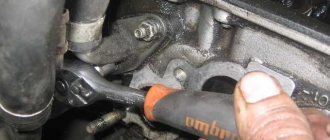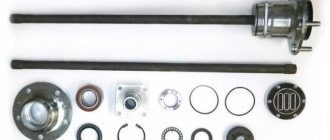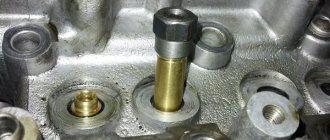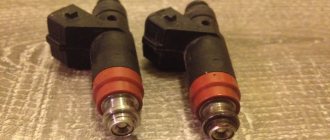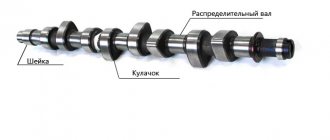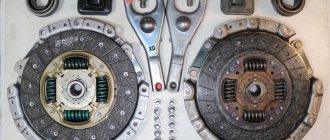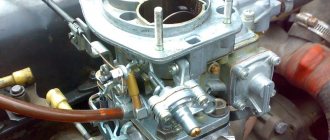Replacing the generator yourself
Typically, the VAZ 2106 generator must be replaced only in the most exceptional cases, and in case of most malfunctions it is simply repaired. But if this device on your car has completely failed and cannot be repaired, then it is necessary to replace it. To make this repair procedure as simple as possible, below is a list of necessary tools that will help make this operation easier:
- Keys for 17 and 19
- Heads for 10, 17 and 19
- Ratchet handles and knobs
- Extension with universal joint
The procedure for removing and installing the generator on a VAZ 2106
Before attempting this repair, disconnect the negative battery terminal. Then you need to disconnect all power wires from the generator itself. First you need to unscrew the terminal securing nut:
Now you can pull out all the other wires and plugs, just pull them to the side with a little effort:
Then we tear off the upper mount of the generator with an ordinary open-end wrench 17, and after that we throw on the head with an extension and a cardan joint to unscrew this nut quickly and without unnecessary effort:
Next, you need to crawl under the car from below and tear off the nut with a spanner wrench and unscrew it completely using the ratchet handle:
After the nut is completely unscrewed, you need to knock the bolt out. To do this, you can use a wooden block, pointing it at the bolt and hitting it several times with a hammer. The photo shows it without a block, but keep in mind that the backing must be present so as not to damage the thread:
After which the bolt can be pulled out by hand. If it is difficult to move, you can resort to penetrating lubricant, spraying it a little in the right place.
Then you can remove the generator from below, as this is more convenient. If it doesn’t give in right away, you can turn it a little in the right direction so that nothing gets in the way when removing it. This is roughly what it looks like in practice, as shown in the photo below:
The price of a new generator for a VAZ 2106 varies from 2,500 rubles and above, it all depends on your wallet. The replacement process is not complicated and installation occurs in the reverse order of removal.
How to remove a VAZ 2107 generator
The VAZ 2107 is located in a rather awkward place. To make it easier to access, it is better to carry out work on a lift or pit. Before work, you need to de-energize the vehicle's electrical systems by disconnecting the battery terminals. Subsequent actions are performed in the following sequence:
- Remove the engine protection and the right front fender liner.
- Disconnect the wires from the generator (with all this, you need to understand how they were connected.
- Loosen the nut holding the generator and remove the belt from it.
- Unscrew the nut from the bolt securing the generator to the bracket. If it is rusty, use WD-40.
- Remove the mounting bolt. If it does not come out, it must be treated with WD-40 and carefully knocked out.
- Remove the generator.
Removing the generator VAZ (Lada) classic 2101-2107
Shown how to remove a generator without a pit
, overpasses, just in the courtyard of a private house.
How to remove a VAZ classic generator. (for beginners.)
how to remove the generator
from a
classic VAZ
Architecture of the VAZ 2106 generator
The VAZ 2106 generator of the G-221 brand produces alternating electric current and is designed to power on-board energy consumers and charge the vehicle battery. By its design, the generator on a car is a three-phase synchronous electrical installation with electromagnetic excitation of right rotation.
Since all consumers on the VAZ 2106 use direct current for their power supply, an electric rectifier, which is built into the VAZ generator, is used to convert the alternating current received by the electric generator into direct current. The electric rectifier circuit is based on the use of six silicon diodes.
The maximum current received from the electric generator at a voltage of 14 V and 5000 rpm is 42 A. The generator on a VAZ is mounted on the engine on the right. The rotation of the electric rotor is carried out by transmitting rotational motion using a V-belt from the crankshaft pulley to a pulley mounted on the rotor of the VAZ generator.
Where is the generator located on the VAZ 2107
The generator on the VAZ 2107 functions in close connection with the battery. As with any other car, this device generates electricity to power all elements of the car. In this case, the generator performs its function only when the engine is running.
On the VAZ 2107 this mechanism is located directly on the surface of the power unit on its right side. This position is due to the fact that the generator is started by the movement of the crankshaft through the V-belt.
Electric generator mounting diagram and its design
To secure the generator to the motor housing, there are special ears on its covers. Fixation is carried out using a bolt to the bracket and a pin to the tension bar. To prevent damage to the cover ears when securing the electric generator, special rubber buffer bushings are inserted into their holes.
When securing the unit, the tightening force leads to displacement of the clamping steel bushing, after which the special buffer bushing is compressed between the metal bushings, and the axial force applied during tightening is not transmitted to the fastening eye. The design of the unit consists of several parts. The main components included in the electricity generating device are:
- rotor;
- stator;
- covers made from aluminum alloy;
- fasteners;
- generator drive pulley.
1 – clamping sleeve; 2 – bushing; 3 – buffer sleeve; 4 – back cover; 5 – screw for fastening the rectifier unit; 6 – rectifier block; 7 – valve (diode); 8 – rear bearing; 9 – slip rings; 10 – rotor shaft; 11 – brushes; 12 – pin “30”; 13 – brush holder; 14 – pin “67”; 15 – neutral wire plug; 16 – generator mounting pin; 17 – fan impeller; 18 – pulley; 19 – plates; 20 – ring; 21 – front bearing; 22 – rotor winding; 23 – rotor; 24 – stator winding; 25 – stator; 26 – front cover.
Almost each of these design components consists of certain individual elements. The rotor consists of a shaft having a corrugated surface, onto which a steel bushing is mounted. In addition, beak-shaped steel poles are placed on the rotor shaft, which together with the shaft and bushing form the core of the electromagnet of the unit.
A pulley and a fan impeller are placed on the rotor shaft, the air flow from which cools the rectifier block circuit and other internal elements of the electric machine. Air is sucked into the cover windows, after which the flow passes inside the electric generator between its stator and rotor and is thrown out through the fan impeller.
The unit pulley and its impeller are made of thin sheet metal. Connected by welding.
Diagram of the electrical windings of the "six" generator
The electrical winding of the rotor is located on a bushing, in a plastic frame, between the beak-shaped poles. It is called the electrical excitation winding. The ends of the electrical winding are brought out through special holes in the poles and soldered to copper slip rings mounted on a plastic sleeve.
The rotation of the electric rotor is carried out on closed ball bearings. The lubricant placed in the bearing housing is sufficient for the entire period of operation of the electric generator. The bearings are pressed into the generator covers and are located between metal washers.
The unit's electrostator core is assembled from special plates made of steel. The inner part of the stator has 36 slots in which the three-phase electrical winding is placed. Plastic tubes are used as wedges to prevent it from falling out of the grooves. Each electrical winding contains six electric coils, the connection diagram of which is sequential.
Brushes and straightener for auto power generating device
The generator brushes are attached to a brush holder fixed on the cover of the unit. The brushes are made of a copper-graphite composition; they are pressed against the slip rings on the rotor using springs. Through the contact brushes, current is supplied to the excitation winding. The negative brush is attached to the ground of the generator by means of a metal plate, and the positive one is connected to the plug of the battery charge control lamp.
The elements that make up the electric rectifier are fixed on the back cover of the unit. An electric rectifier changes alternating electric current to direct current. The design of the electric rectifier is assembled on the basis of a three-phase bridge circuit. This electric generator component consists of six BA20 diodes.
These silicon diodes are semiconductor devices capable of passing electric current in one direction. The diode bridges are located in an aluminum housing. Three diodes from the rectifier block have a “plus” on their housing. These ends are pressed into the housing holder. Three more diodes of the rectifier block on the housing have a “minus” one. These diode bridge elements are connected to the ground terminal.
1 – “negative” brush; 2 – brush holder; 3 – “positive” brush; 4 – neutral wire plug block; 5 – insulating bushings of the contact bolt; 6 – rectifier block; 7 – contact bolt; 8 – stator; 9 – rotor; 10 – inner bearing mounting washer; 11 – drive side cover; 12 – fan assembly with pulley; 13 – outer bearing mounting washer; 14 – front rotor bearing; 15 – spacer ring; 16 – coupling bolt; 17 – clamping sleeve; 18 – cover from the side of the slip rings; 19 – buffer sleeve; 20 – bushing.
To ensure high-quality heat removal, the rectifier unit diodes are pressed into original holders made of aluminum. Repair of the rectifier unit is impossible; if any of its elements fail, the entire rectifier is replaced.
The generator is connected by connecting the negative terminal of the unit to the vehicle ground, and the positive terminal is connected to the on-board network. The operation of the electric generator is carried out as follows. When the ignition key is switched to the first position, an electric current is passed through the electrical excitation winding, creating a magnetic field.
As a result, when the rotor rotates, the south and north poles of the rotating part pass alternately under the stator teeth. This reversal of poles produces an electromotive force. The shape of the poles allows you to optimize the operation of the unit.
Generator VAZ 2106
A car generator is necessary to generate energy after the ignition is supplied to the engine. The principle of operation of the generator is to convert the mechanical energy of the motor into electricity by rotating the electric motor through the drive belt.
It is the operating conditions of the generator that determine its service life - for example, on a VAZ 2106, the service life of the device does not exceed 50,000 km, after which the unit, as a rule, needs to be repaired.
Generators for VAZ 2106 “Six”: select the appropriate model by article number
The standard generator on the “six” operates at a voltage of 14 Volts and produces about 42 Amperes. However, most drivers install generators of higher power - a stronger unit allows you to connect additional electrical equipment.
However, it must be remembered that a strong increase in the power of the generator requires replacing the main wiring in the car - otherwise there is a high risk of the cables catching fire due to overheating.
Note! Before purchasing a new generator, it is recommended to enter the part number and VIN code of the vehicle on the manufacturer’s official website. This type of verification will prevent the possibility of purchasing a counterfeit part - if there is no information about the part in the database, you must refuse the purchase.
Dismantling and removing the generator from a VAZ 2106: step-by-step instructions
The algorithm for extracting the generator on the “six” is not complicated and can be easily performed with one pair of hands. For dismantling, you will need a standard set of wrenches, as well as a small hammer or mounting blade, and pliers. Removal of the unit is carried out in the following sequence:
- First of all, it is necessary to remove the power terminals from the battery - this will prevent a short circuit in the wiring and electric shock;
- Next, we find the generator and unscrew all the wires leading to the unit. Depending on the cross-section of the wiring, some cables can be screwed to conductive parts with “19” nuts;
- After removing the wiring, you must carefully release the attachment of the unit to the upper bracket - this will allow you to slightly move the generator away from the seat, which will reduce the tension on the drive belt. The belt itself must also be removed, being careful not to damage the tensioner;
- Next, we go under the bottom of the car and remove the crankcase protection, if present. Then you need to unscrew the fasteners on the bottom of the fixing bracket, after which the generator can be removed.
- It will be most convenient to dismantle the unit through the bottom of the car.
Note! An old drive belt, soured or licked nuts, as well as oxidized terminals and torn insulation must be replaced during reassembly and installation of the generator. Otherwise, the resource of the unit will be reduced, and the risk of short circuit will, on the contrary, be increased.
Disassembling and repairing a generator on a VAZ 2106: a detailed guide for beginners
How to replace the generator on a VAZ 2107
Replacing a generator set is required in cases where the device no longer produces the required amount of current for consumer systems. The most common reasons for replacing an installation are the following malfunctions and breakdowns:
- burnt winding;
- interturn short circuit;
- deformation of the generator housing;
- resource development.
It is almost always easier and more profitable to replace the generator with a new one than to repair it.
Tool preparation
To dismantle and subsequently install the generator on a VAZ 2107, you will need a standard set of tools, which every driver usually has in his garage:
- wrench 10;
- wrench 17;
- wrench 19;
- a pry bar or a special shovel for installation work.
No other devices or devices are required.
Dismantling works
It is recommended to remove the generator from the “seven” after the engine has cooled down. It is not recommended to work with vehicle components immediately after driving due to high temperatures and the risk of injury.
Immediately before removing the generator, you will need to remove the right front wheel, since the installation can only be reached from under the bottom of the car through the right fender.
It is imperative to securely fix the position of the car with a jack and auxiliary devices (hemp, stands) in order to eliminate the risk of the car falling during operation.
The progress of work comes down to the sequential implementation of the following actions:
- Find the generator housing in the mechanical structure of the car, feel for the bar that secures it to the engine.
- Using a wrench, unscrew the fastening nut halfway.
- Unscrew the nut on the bracket, but do not remove it from the stud.
- The generator housing can be pulled and moved in any direction - this will become possible due to the loose fastening.
- Remove the belt from the landing pulleys and remove it from the work area.
- Disconnect all incoming wires to the generator housing.
- Unscrew the fastening nuts completely.
- Pull the generator towards you and remove it from under the body.
Photo gallery: main stages of work
Immediately after dismantling work, you should inspect the generator landing site. All joints and fastenings must be cleaned of dirt and, if necessary, treated with acetone.
Accordingly, installation of the new generator will need to be carried out in the reverse order, paying special attention to tensioning the new belt.
VAZ 2106 car generator - device, design features
For bearing 6, the inner race is pressed onto the rotor shaft, and the outer race is pressed into the cover seat 1 with a rubber ring. The stator core 27 is made of electrical steel plates. In the grooves of the core there is a three-phase winding connected in a star circuit to the zero point output. This terminal is unmarked and serves to connect the battery charge warning lamp relay. The main three terminals of the stator winding are connected to a rectifier unit consisting of six silicon diodes. Since 1982, a rectifier unit has been installed, consisting of two plates with diodes pressed into them. If the diodes fail, the rectifier unit is replaced with a new one. The electrical connection diagram of the generator system is shown in Fig. 9.2.
WARNING The negative of the battery should always be connected to ground, and the positive should always be connected to terminal 30 of the generator. Incorrectly turning the battery back on will immediately cause increased current through the alternator diodes and they will fail. It is not allowed to operate the generator with the battery disconnected. This will cause short-term overvoltages to occur at terminal “30” of the generator, which can damage the generator voltage regulator and electronic devices in the on-board network of the VAZ 2106 car.
It is prohibited to check the functionality of the generator “for spark” even by briefly connecting terminal “30” of the generator to ground. In this case, significant current flows through the diodes and they are damaged. The generator can only be checked using an ammeter and voltmeter. The diodes of the generator rectifier unit cannot be checked with a voltage of more than 12 V or with a megger, since it has a voltage too high for the diodes - during testing they will be broken (a short circuit will occur). It is prohibited to check the electrical wiring of a VAZ 2106 car with a megger or a lamp powered by a voltage of more than 12 V. If such a check is necessary, you must first disconnect the wires from the generator. The insulation resistance of the stator winding with increased voltage should only be checked on a bench and always with the terminals of the phase windings disconnected from the diodes.
USEFUL TIPS If the alternator belt breaks along the way, and you forgot the spare one at home, a 20 mm wide ring cut from an old car inner tube can temporarily replace it. To reduce current consumption when driving a VAZ 2106 with a faulty generator, if possible, turn off the radio, unnecessary lighting, heater fan, heated glass, etc.
Rice.
9.1. Generator of a VAZ 2106 car: 1 - generator cover from the side of the slip rings; 2 - rectifier block; 3 — bolt for fastening the rectifier unit and the phase terminals of the stator winding; 4, 5 — slip rings; 6 — ball bearing of the rotor shaft on the side of the slip rings; 7 — rotor shaft; 8 — insulating sleeve; 9 — brush holder fastening screw; 10 — “positive” terminal bolt (pin “30”); 11 — insulating sleeve of the contact bolt; 12 — plug of the central output of the stator winding; 13 — brush holder; 14 - negative brush; 15 - positive brush; 16 — pin for attaching the generator to the tension bar; 17 — pulley impeller; 18 — beak-shaped pole piece of the rotor from the drive side; 19 — generator drive pulley; 20 — pulley fastening nut; 21 — bearing spacer ring; 22 — ball bearing of the rotor shaft on the drive side; 23 — generator cover from the drive side; 24 — rotor winding frame; 25 — rotor winding; 26 — stator groove insulation; 27 - stator; 28 — stator winding wedge; 29 — stator winding; 30 - rotor; 31 — coupling bolt; 32 — buffer sleeve; 33 — bushing; 34 - negative diode; 35 - insulating plate; 36 - phase output wire of the stator winding; 37 - positive diode; 38 — holder of positive diodes; 39 — insulating sleeve; 40 - negative diode holder
Rice. 9.2. Diagram of the G-221 generator system (the voltage regulator RR-380 of the electromagnetic type is shown):
1 — generator rotor winding; 2 - generator; 3 — generator stator winding; 4 — generator rectifier; 5 - battery; 6 — ignition switch; 7 — battery charge indicator lamp; 8 — battery charge warning lamp relay; 9 — fuse block; 10 - throttle; 11 — thermal compensating resistor; 12 — additional resistors; 13 - voltage regulator
VAZ 2106 charging circuit and equipment composition.
The charging circuit for VAZ 2106 cars includes an external voltage regulator, a generator, a charging warning lamp relay and a battery charge monitoring lamp located on the instrument panel.
Generator.
Cars use an alternating current generator with a built-in rectifier. The generator is driven by a mono-V belt from the crankshaft pulley.
Relay regulator.
The voltage regulator relay ensures that the voltage generated by the generator is maintained within the range of 13.5 - 14.5V. and is located in the engine compartment on the left wing. On older models, the voltage regulator was of the magnetic contact type. The voltage regulation in this relay was carried out by closing and opening the contacts of the electromagnetic relay when the voltage increased and decreased. Currently, an electronic relay is used as a regulator, which is completely interchangeable with the old one. But the use of an electronic relay, unlike a contact one, does not allow removing the terminals from the battery while the engine is running. This can lead to a sudden voltage surge and failure of the regulator and other electronic devices. To check the serviceability of the circuit and the presence of charge, you must use a voltmeter.
Warning lamp relay.
The charging circuit of the VAZ 2106 includes a charge indicator relay of the RS-702 type that turns on and off the warning light on the instrument panel, which indicates the presence or absence of charge and the serviceability of the generator. The relay is located on the right wing in the engine compartment. The design of the relay is the same as that of an ordinary electromagnetic relay. The relay contacts are normally closed, that is, the contacts are closed when there is no power to the coil. One end of the coil is connected to the positive of the battery through the ignition switch, and the other to the generator phase terminal. One of the relay contacts is also connected to the positive through the ignition switch; in fact, it is connected to the corresponding terminal of the coil, and the second to the control lamp.
When the ignition is turned on, the electromagnetic coil of the relay receives power, but the coil is not connected to the minus and therefore no current passes through it and the armature is not attracted to the core. In this case, the relay contacts remain closed, which leads to the warning lamp on the instrument panel lighting up. When the generator operates, an alternating voltage appears on the stator winding. A potential difference will appear at the ends of the coil, and current will begin to flow through it. When the voltage value is about 7.5V, the magnetic flux force of the electromagnet will be sufficient to attract the armature and open the contacts.
Features of operation and connection diagram of the generator on the VAZ 2106
In order for a working generator in a VAZ to serve you for a long time, the main requirement is not to overload the device. It is important to periodically carry out preventive maintenance, replace consumables - brushes, and also monitor the tension of the strap. On car 2106, the generator is connected according to the electrical diagram below.
Connection diagram of the node to the on-board network of the “six”
How to remove the generator on a VAZ 2107?
How to remove the generator on a VAZ 2107? - one of the most common questions among owners of VAZ classics. They are asked when the winding burns out, the generator brushes need to be replaced, an interturn short circuit occurs, etc. And even though there is nothing complicated in the answer (the generator in the “seven” is removed in just 8 consecutive steps), a beginner with this process may have problems serious problems. To prevent this from happening, act strictly according to the instructions described below.
Diagnostics
How to remove and disassemble the device on your car, how to repair connections? Before we tell you how to disassemble and reassemble the voltage device on a VAZ 2106 with your own hands, we’ll take some time for diagnostics. How to test a generator at home? In total, there are three testing methods - on the machine itself, on a stand, and also using an oscilloscope. The last two methods are not of interest to us, since they require specific knowledge and the use of equipment.
The VAZ 2106 generator cannot be diagnosed by disconnecting it from the battery, as this will lead to a voltage surge, as a result of which the rectifier unit may fail. If you have ever had to check the voltage regulator of a VAZ 2106, then in the case of a generator unit the diagnostic procedure will be identical.
First of all, you will need to start the engine, the engine should be running at 2500-300 rpm, and the battery should be maximally charged. Using a multimeter, measure the voltage at the battery terminals - this parameter should be 14 volts. If the indicators differ, the problem must be looked for either in the voltage relay or in the device itself. If you have adjusted the voltage relay, but the problem remains, the unit will have to be either repaired or replaced.
Checking voltage with a multimeter
Common faults
What malfunctions of the VAZ 2106 generator exist and how to eliminate them?
The first type of breakdown is when the light on the dashboard is always on or lights up from time to time while driving, the reasons are as follows:
- The strap is slipping - its tension needs to be adjusted.
- Open circuit between the center of the star assembly and plug number 85 of the warning light relay.
- The charge indicator relay is damaged.
- Voltage regulator failure.
- Break in the field winding wiring.
- The generator brushes are worn out and the slip rings are oxidized. The problem can be solved by cleaning the rings, as well as replacing the generator brushes.
- There is a short circuit or break in the valve circuit of the mechanism.
- Short circuit in the wiring in the stator winding or open circuit.
If the warning light does not light up when the ignition is turned on, the reasons may be as follows:
- The filament has burned out - the light bulb can simply be replaced.
- Failure of the light bulb relay.
- Broken wiring or shorted valves.
- The stator winding is shorted to ground. Replacing the stator will solve the problem.
- The generator does not charge the battery.
Design and designation of node elements
If the generator unit is functioning normally, but the battery is not charging well, the reason may be:
- Poor belt tension or slipping when driving at high speeds. You can get rid of this problem by adjusting the strap tension.
- The terminals on the battery have oxidized, the wiring has been damaged, or the clamps of the wiring tips on the mechanism have become loose.
- If the battery fails, it must be replaced.
- Problems with the operation of the voltage regulator can be corrected by cleaning the contacts, as well as adjusting or replacing the element.
As for battery overcharging, it is usually caused by poor contact between the body of the regulatory element, as well as the ground. Much less often this is due to failure of the regulator itself, as well as battery failure.
If the generator unit operates very loudly, this is due to:
- By loosening the pulley nut of the unit - you just need to tighten it.
- By bending the fan blade - you just need to rebuild it.
- Incorrect operation of bearing elements.
- Short circuit or broken wiring in the mechanism.
- The brushes of the assembly can contribute to the appearance of noise - you just need to wipe them (the author of the video is Sergey Bakaev).
Charging circuit for VAZ 2106 operating principle.
Let's consider the operation of the VAZ 2106 charging circuit circuit. When the ignition is turned on, pin 15 of the voltage regulator receives power through the generator excitation winding fuse. Then, from pin 67 of the regulator, power flows to the positive brush of the generator, through the field winding (armature winding) to the negative brush and ground. In this case, an electric current will flow through the armature winding. A magnetic field will appear in the winding, which magnetizes the armature plates with teeth. When the armature rotates, the teeth rotate inside the stator winding, inducing an alternating magnetic field in it and which leads to the appearance of alternating current. How to find the fault is written in the following article “No charging VAZ 2106”.
admin 07/08/2014
“If you notice an error in the text, please highlight this place with the mouse and press CTRL+ENTER” “If the article was useful to you, share the link to it on social networks”
Dismantling and removal
How to remove a VAZ generator and how to disassemble the device? Which generator is better to install on a VAZ 2106?
To repair a VAZ 2106 generator, follow these steps:
- First you need to disconnect the plug from output 67 on the node.
- After this, the plug is disconnected from the output of the so-called neutral wire.
- Next, you need to move the insulating cover a little, after which, using a 10-mm wrench, you need to unscrew the nut that secures the wiring, in particular, we are talking about the thirtieth pin. The wiring can be disconnected.
- Now you can remove the strap. If you only need to replace it, then buy a good belt - check its condition, there should be damage on the strap. The size of the VAZ 2106 alternator belt must correspond to the nominal one; it is indicated in the service manual.
- Using a 17mm wrench, you need to unscrew the two nuts that secure the adjustment bar; it needs to be removed.
- Then unscrew the nuts of the lower mechanism clamp, remove the bolt, as well as the bushing. The assembly itself will be fixed on the bracket.
- After this, the unit can be dismantled. If necessary, the generator is replaced. Further connection of the generator is carried out in the reverse order of removal.
Sorry, there are no surveys available at this time.
Installation and connection of the generator
Initially, when installing the generator on a VAZ 2106, it is important to connect the bottom mount to the engine, for which you need to:
- Attach the bottom mount of the product to the corresponding device on the power plant, and connect it through the bushings with a bolt, followed by securing the joint with a nut.
- Attach a pin to the upper fastening of the belt tension bar and screw on the nut.
- Connect the positive battery cable to connector “30”.
- Secure the central type winding plug.
- Pull the drive belt onto the pulleys of the associated units.
- Using a crowbar or pry bar as a lever, press the EDH away from the motor and, maintaining the tension force, tighten the fasteners on the upper type bar.
- Tighten the bottom fastening nut until it stops.
In order to solve the problem of how to remove a VAZ 2106 generator, it is necessary to carry out all technological operations in the reverse order. The VAZ 2106 generator is checked to avoid such negative consequences as increased wear of the product bearings and belt drive breakage if there is excessive tension on this element of the generator set.
On the contrary, an insufficient degree of tension on the belt drive will lead to weak recharging or a complete loss of charging current. This is due to the fact that the drive belt will slide along the generator and motor pulleys without transmitting torque to the electric machine.
Correct connection of the VAZ 2106 generator guarantees trouble-free and reliable operation of this electrical unit of the vehicle. The stability in the functioning of this electric machine allows you to significantly extend the life between repairs of the car battery. If, when checking the generator for recharging, the battery charge “monitoring” banner lights up, you should not rush into such an operation as replacing the generator, because there are such defects as a broken drive belt or unstable wiring contact. This must be checked first; much more serious damage occurs from vehicle vibration.
Sometimes you need to solve the problem of how to check the VAZ 2106 generator for the functionality of the network regulator, which can be found on the left mudguard in the engine compartment. To do this, you need to de-energize all current consumers of the car, increase the engine speed to 2.5 thousand units, and use a voltmeter to measure the voltage parameters at the battery contacts, which should be within 14 V.

